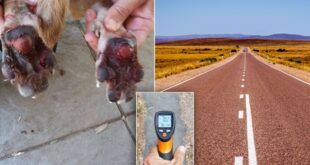The majority of Spanish dog owners have adjusted their routines as the summer temperatures increase and shade is a valuable commodity. Many dog walkers in Spain now go out early or late to exercise their dogs, bring portable water bowls and never leave them parked in cars.
While awareness of the risks has increased in recent years, many new heat and insect-related hazards remain largely undetected until a dog’s health is compromised.
Here is what responsible owners in Spain should be thinking about this summer—beyond the basics.
Leishmaniasis risk increases with longer Sandfly season
Leishmaniasis is a parasitic disease that is spread by sandflies. It has been an endemic problem in Mediterranean Spain for a long time. Recent studies show that the season has been extended. Sandfly activity was confirmed in March and even as late as November.
Sandflies are a problem for dogs who live in urban areas. They can be found in dog parks, residential gardens and patios.
The first line of defense should be repellents containing permethrin and deltamethrin. Collars such as Scalibor® or monthly spot-on treatments like Advantix® are effective—but only when used consistently.
Leishmania vaccine is a common misperception. It helps to prepare the immune response, but it doesn’t prevent infection. Experts recommend three parts: repellents (including vaccination), regular blood tests, and vaccines.
Heat Stroke can kill within minutes if you don’t know the signs
Despite growing awareness, heat stroke remains one of the deadliest summer risks for dogs in Spain—particularly among short-nosed breeds, senior dogs, and those exercised during hot or humid periods.
The following are the key signs of heatstroke:
- Heavy panting, laboured breathing
- Drooling excessively or sticky, thick saliva
- Bright red gums (gums can turn pale or grey in severe cases).
- Disorientation or collapse
- Vomiting and diarrhoea
- Seizures and unconsciousness
It is an emergency if a dog lies down suddenly in the heat, refusing to move.
What to do?
- The dog should be moved immediately to an area that is cool and shaded.
- Do not use ice water. Instead, cool (not freezing) water should be used to wet the dog, particularly around the stomach, paws and neck.
- If possible, place a fan near the window.
- Offer small amounts of water—but do not force drinking
- Seek immediate emergency care. Even if it seems that the dog is recovering, there may be internal damage.
If not treated, heat stroke can cause organ failure in minutes. Dogs that have dark coats and are obese are at a higher risk.
Paw Pads & Fans: Subtle cooling that works
Walking early or late is essential, but pavement temperatures in much of southern Spain can remain above 45ºC well into the evening. Dogs’ paw pads, which are one of their few sweating areas, can become damaged and overheated. This will affect the ability to cool off.
Applying coconut oil or paw balm after a walk helps to hydrate, protect and cool paw pads.
Indoors fans placed near areas of rest provide a simple and efficient way to relieve heat stress. This strategy is also effective in avoiding air currents.
According to recent studies, dogs can sleep as little as 40% less when there is a heatwave. Lack of rest alone can elevate stress hormones and weaken immune response—raising susceptibility to infection and behavioural changes.
Diet and Heat Tolerance: A Link between Gut Health
The hot weather can cause dogs to lose appetite, especially if they are on a dry kibble diet. A less obvious issue is chronic low-level dehydration. This can cause inflammation in the gut and lead to irritability, decreased tolerance to heat or even a decrease in tolerance.
Dogs can stay healthy during the summer by following these recommendations:
- The kibble is soaked in either water or unsalted bone broth
- Offer hydrating, natural snacks like frozen cucumbers, goat yogurt or whole canned sardines. (The bones are safe and soft).
- Add fresh mint or parsley with meals to stimulate thirst and aid digestion
- Offering mashed sweet potatoes as a healthy, mild alternative that is rich in vitamins
- In the summer months, bacterial infections are more prevalent. Maintaining probiotics through supplements or foods rich in probiotics like kefir is a good idea.
- Sugar content in sweet fruits such as watermelon and apple can be harmful to overweight dogs.
Hydration is not just about water intake—it is also about what is included in their diet. How dogs deal with heat and stress is largely determined by their gut.
Mood and Behavior: Subtle Signs of Summer Stress
Both physical and behavioral symptoms are used by dogs to express heat stress. Some dogs become irritable or aggressive, refuse to eat and are less tolerant towards other animals. Some dogs may be licking their paws excessively or refusing to stay indoors.
These changes can be misinterpreted as being age-related, behavioural, or due to poor sleep. They may also indicate low-grade heat-stress, dehydration or a lack of water.
The following are some helpful strategies:
- Frozen toys containing broth or lactose free yogurt
- Use wet towels or cooling mats to cool tiled floors
- Scheduled quiet times in ventilated, darkened rooms
- Avoiding overstimulation in the midday hours
The Bottom Line
Spain’s dog owners are becoming better informed—but climate shifts are creating new challenges. The new reality includes longer sandfly season, subtle dehydration and heat-related gut sensitivity.
The signs that dogs give are very clear. It is up to owners to notice early—and act quickly.
 Costa News Spain Breaking News | English News in Spain.
Costa News Spain Breaking News | English News in Spain.





